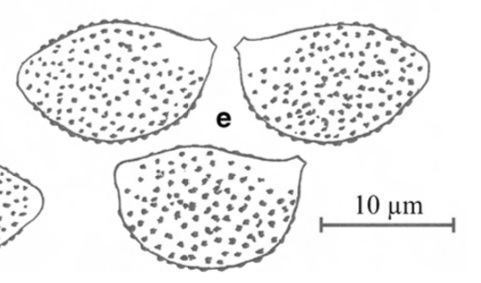Cortinarius seidlii Ammirati, Niskanen & Liimat
Index Fungorum number: IF551440 Facesoffungi number: FoF01002
Etymology: Named after Michelle T. Seidl.
Holotype: T. Niskanen 09-132 (H). Pileus 40–80 mm, at first hemispherical, then low convex to plane with a low and broad umbo and with margin plane to uplifted, strongly radially wrinkled, dirty ochraceous olive brown to brown, center dark brown but ochraceous when dried, edge at least at first whitish or pale, strongly glutinous, hygrophanous. Lamellae medium spaced, emarginated, at first very pale brown, later pale brown, sometimes with a purple tinge. Stipe 80–150 mm long, 7–15 mm thick at apex, 10– 21 mm at the broadest portion, cylindrical to narrowly ventricose, base tapered to rounded, white, and glutinous. Universal veil glutinous, very pale purple to pale purple, sometimes almost white. Context in pileus brown, in stipe apex whitish to very pale brown, in base of the stipe pale yellow brown. Odor in the context of the stipe base indistinct, faintly iodoform-like or sweet. Lamellar trama hyphae smooth, somewhat yellow in Melzer’s reagent. Basidia 4-spored. Basidiospores(12–)12.5– 14.5(−15)× (7.5–)8–9 μm (x = 13.5×8.5 μm, Q=1.5– 1.7(−1.8), n=40), broadly citriform, moderately, densely verrucose, almost indextrinoid to somewhat dextrinoid. Pileipellis. Hyphae in the surface layer 3–6 μm wide, hyaline, without clamp connections, embedded in mucus. Hyphae under the surface layer 5–17 μm wide, pigmented, brownish yellow in Melzer’s reagent, finely to coarsely encrusted. ITS sequence (GenBank KR011125, holotype) distinct from the other known members of the section Defibulati and differs from them it in the ITS region by more than 10 substitutions and indel positions.
Habitat and distribution: In mesic, mossy coniferous forests (Pseudotsuga, Tsuga, Abies). Producing basidiomata from late summer to late autumn. Common in Pacific North West of North America, known from USA. Oregon to Canada British Columbia.
Material examined: USA, Oregon, Clackamas Co., Bull Run Watershed, fairly mesic, mixed coniferous forest (Tsuga, Pseudotsuga, Abies), 8 September 1995, L. Norvell, M.T. Seidl 4166 (WTU) (as C. vanduzerensis). Washington, Olympic Peninsula, Sol Duc camp ground, coniferous forest (Tsuga heterophylla, Pseudotsuga), 25 October 2009, K. Liimatainen & T. Niskanen 09-132 ((holotype, H), isotype, NY). Snohomish Co., Boardman Lake Trail, coniferous forest (mostly Tsuga heterophylla), 5 October 2009, J.F. Ammirati & T. Niskanen 09-063 (H); Mount Rainier National Park, Cougar Rock Campground, Tsuga, Abies, Pseudotsuga, 18 October 1995, J.F. Ammirati 11591 (WTU) (as C. mucifluus). Olympic Peninsula, Big Quilcene Trail, Abies, Tsuga, Pseudotsuga, deep humus, 11 October 1995, J.F. Ammirati 11543 (WTU). CANADA, British Columbia, Tsuga heterophylla ectomycorrhizal root tip, GenBank ITS: FJ152500 (as C. sp.). Mt. Washington, Trail to Divers Lake, 12 September 2001, O. Ceska OC44, F17116 (UBC) (as C. cf. pseudosalor). Port Renfrew, near the 2nd Bridge on Way to Fairy Lake, 24 August 2003, O. Ceska OC131, F17203 (UBC) (as C. stillatitius). Queen Charlotte Islands, Moresby Island, West side of Rose Inlet, Boschniakia Point, 5 September 2005, O. Ceska et al., F15962 (UBC), (as C. cf. vanduzerensis). Roberts Creek, Mt. Elphinstone Provincial Park, Upper Area #1, 22 August 2000, P. Kroeger, PK5331, F16402 (UBC), (as C. vanduzerensis); 3 September 2000, P. Kroeger, PK5336, F16403, (as C. vanduzerensis); area #2, in old growth Pseudotsuga, 4 September 2000, K. Goodwin & P. Kroeger, PK3374, F15805 (UBC), (as C. cf. vanduzerensis); area #3, 5 November 2000, K. Goodwin & P. Kroeger, PK3396, F15827 (UBC), (as C. cf. vanduzerensis). USA, Oregon, HJ Andrews Experimental Forest, Pseudotsuga menziesii, OSC 1064174 (OSC), (as C. sp.).
Notes: Cortinarius seidlii is a typical member of /Defibulati. Members in this clade are characterized by the medium to large basidiomata, glutinous pileus and stipe, large, amygdaloid to citriform spores, and the absence of clamp connections. Cortinarius seidlii is characterized by the dirty ochraceous olive brown to brown pileus with dark brown center, very pale purple to pale purple, glutinous universal veil, and broadly citriform spores. Originally the species was identified as C. vanduzerensis A.H. Sm. & Trappe, but the study of the type specimen of C. vanduzerensis (MICH10434, GenBank ITS: KR011130, holotype) revealed that it is a different species. The pileus of C. vanduzerensis is chestnut black with chestnut brown margin and the spores are narrower 7–8(−9) μm wide. The species is currently only known for sure from the type locality, Tillamook Co, Oregon. Cortinarius stillatitius Fr. is also very similar to C. vanduzerensis, but it has a strong honey-like smell in the context of the base of the stipe and it does not occur in Pacific North West. Cortinarius brunneoalbus, which occurs in the same area, can be distinguished from C. seidlii by the narrower spores, Q=1.75, and the white stipe. ITS sequence (GenBank KR011125, holotype) distinct from the other known members of the section Defibulati and differing from them in the ITS region by more than 10 substitutions and indel positions.


